We now have an outstanding capability for photo-physiological characterization of genotypic variation and plant responses to growth conditions and environmental stress. Understanding the efficiency of carbon assimilation; which parts of the light capture and carbon fixation mechanisms are limited or enhanced, significantly strengthens the analytical potential of our research output.
Chlorophyll fluorescence:
Many treatments, such as chilling, drought, the application of herbicides and other environmental challenges, affect chlorophyll fluorescence before there are any other measurable effects on the plant. Measurement of chlorophyll fluorescence therefore allows rapid, early and non-invasive detection of stress. Even the effect of treatments that perturb metabolic processes other than photosynthesis may be investigated since many of these affect fluorescence indirectly. Chlorophyll fluorescence is extremely effective in screening for variations in photosynthetic performance, identification of metabolic perturbations, and the potential for growth and yield.
We can perform simple and fast screening using one of two Walz PAM-2500 fluorometers, or two 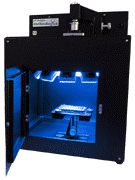 Hansatech continuous excitation fluorometers, or the Technologica chlorophyll imager which can produce images of F’, Fm’, Fq’/Fm’, NPQ (and more).
Hansatech continuous excitation fluorometers, or the Technologica chlorophyll imager which can produce images of F’, Fm’, Fq’/Fm’, NPQ (and more).
More complex and informative measurements such as rapid light response curves, can then be made on selected individual plants.
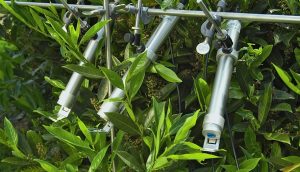 Our Walz Monitoring PAM is designed for unattended, long-term and multi-leaf monitoring of chlorophyll fluorescence in the glasshouse or field. Measuring 6 plants simultaneously, the compact and robust emitter-detector units measure modulated chlorophyll fluorescence and perform saturation pulse analysis. The Monitoring PAM measures photosynthetically active radiation (PAR) and temperature at the leaf level to calculate relative electron transport rates and photochemical yields of photosystem II.
Our Walz Monitoring PAM is designed for unattended, long-term and multi-leaf monitoring of chlorophyll fluorescence in the glasshouse or field. Measuring 6 plants simultaneously, the compact and robust emitter-detector units measure modulated chlorophyll fluorescence and perform saturation pulse analysis. The Monitoring PAM measures photosynthetically active radiation (PAR) and temperature at the leaf level to calculate relative electron transport rates and photochemical yields of photosystem II.
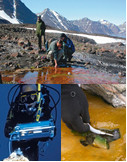 For the more adventurous, the Walz Diving PAM Underwater Fluorometer is a unique instrument for studying in situ photosynthesis of underwater plants, including sea grasses, macroalgae, and zooxanthellae in corals. It functions similarly to the PAM 2500 system however it is also extremely robust and suitable for field work in extreme environments or where other sensitive equipment may fail.
For the more adventurous, the Walz Diving PAM Underwater Fluorometer is a unique instrument for studying in situ photosynthesis of underwater plants, including sea grasses, macroalgae, and zooxanthellae in corals. It functions similarly to the PAM 2500 system however it is also extremely robust and suitable for field work in extreme environments or where other sensitive equipment may fail.
IR Gas analysers:
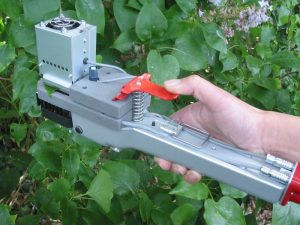 Our infrared gas analyser systems (Walz GFS-3000FL) are able to provide carbon assimilation rates and full photosynthesis response curves (A/Q, A/Ci). Light response curves measure plant response(s) to light intensity. These measurements explore the difference in dark respiration rate, the maximum apparent quantum efficiency, light saturated photosynthesis and light compensation point (the light level at which photosynthesis equals respiration). CO2 response curves indicate plant responses to CO2 concentrations, which provides information on the biochemical limitations to photosynthesis. These data can be used to assess the maximum rate of Rubisco (or PEPc) carboxylation, maximum rate of electron transport for RuBP regeneration and triose phosphate utilization, and other parameters including the effect of stomatal limitation on H2O and CO2 diffusion. The Walz GFS-3000FL gas analysers have the added capability to do temperature and relative humidity response curves, and can be used to identify at what point stomata close or begin to limit CO2 influx into the leaves. The system can also simultaneously measure CO2, H2O and respiratory fluxes in response to stress.
Our infrared gas analyser systems (Walz GFS-3000FL) are able to provide carbon assimilation rates and full photosynthesis response curves (A/Q, A/Ci). Light response curves measure plant response(s) to light intensity. These measurements explore the difference in dark respiration rate, the maximum apparent quantum efficiency, light saturated photosynthesis and light compensation point (the light level at which photosynthesis equals respiration). CO2 response curves indicate plant responses to CO2 concentrations, which provides information on the biochemical limitations to photosynthesis. These data can be used to assess the maximum rate of Rubisco (or PEPc) carboxylation, maximum rate of electron transport for RuBP regeneration and triose phosphate utilization, and other parameters including the effect of stomatal limitation on H2O and CO2 diffusion. The Walz GFS-3000FL gas analysers have the added capability to do temperature and relative humidity response curves, and can be used to identify at what point stomata close or begin to limit CO2 influx into the leaves. The system can also simultaneously measure CO2, H2O and respiratory fluxes in response to stress.
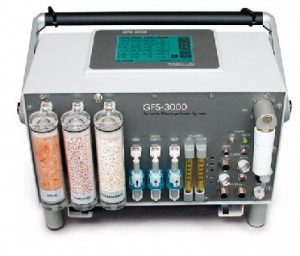 The gas analysis equipment has recently been modified to allow for measurements at varying O2 concentrations, to allow for accurate simultaneous measurements of gas exchange and chlorophyll fluorescence to determine the rate of photosynthesis and photorespiration, providing essential information regarding genotype specific carbon gain and carbon losses in response to any environmental conditions and genetic variation.
The gas analysis equipment has recently been modified to allow for measurements at varying O2 concentrations, to allow for accurate simultaneous measurements of gas exchange and chlorophyll fluorescence to determine the rate of photosynthesis and photorespiration, providing essential information regarding genotype specific carbon gain and carbon losses in response to any environmental conditions and genetic variation.
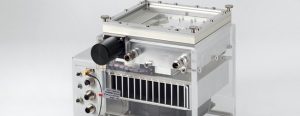 The Gas-Exchange Chamber 3010-GWK1 is designed to investigate medium-sized samples like small branches, big leaves or whole seedlings. The chamber can accurately control temperature, air humidity, and PAR. The chamber has an independent light source and can be operated as part of the GFS-3000FL system.
The Gas-Exchange Chamber 3010-GWK1 is designed to investigate medium-sized samples like small branches, big leaves or whole seedlings. The chamber can accurately control temperature, air humidity, and PAR. The chamber has an independent light source and can be operated as part of the GFS-3000FL system.
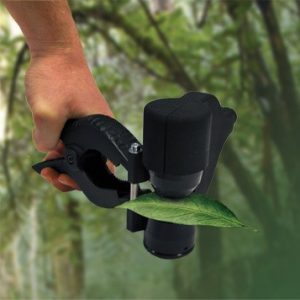 The Ocean Optics SpectroClip measures the transmission, reflection and absorption characteristics of leaves and can provide wavelength ranges from 300-1000 nm. We can produce absorbance profiles and characterize genotypic or environmentally driven changes in light absorption. We use this in conjunction with combined chlorophyll fluorescence and gas exchange, so that we can quantify the amount of photons absorbed by a leaf, and the resulting molecules of carbon assimilated through photosynthesis.
The Ocean Optics SpectroClip measures the transmission, reflection and absorption characteristics of leaves and can provide wavelength ranges from 300-1000 nm. We can produce absorbance profiles and characterize genotypic or environmentally driven changes in light absorption. We use this in conjunction with combined chlorophyll fluorescence and gas exchange, so that we can quantify the amount of photons absorbed by a leaf, and the resulting molecules of carbon assimilated through photosynthesis.
We have the capability to characterise all of the key photosynthetic processes and identify the photo-physiological genotypic variation or effect of environmental treatments that are influencing carbon fixation processes and growth. We can measure all of the processes occurring from light absorbance, and electron transfer to RuBP regeneration or Rubisco activity (and the key processes in between).

